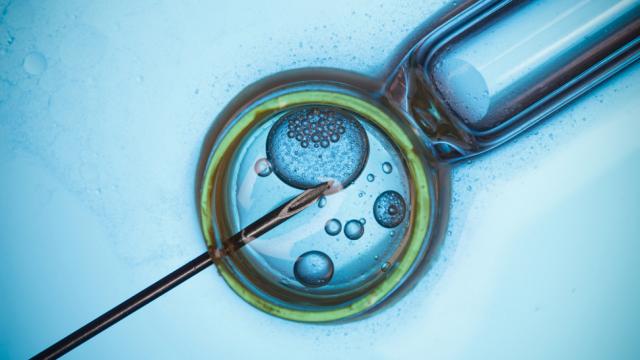Scientists say that a groundbreaking fertility treatment to correct potentially harmful genetic mutations has the potential to backfire, recreating the exact mutation the intervention was meant to fix. It’s a problem that could put an immediate halt to the pending practice — but a work-around may be possible.
Image: Shutterstock
Mitochondrial replacement therapy, or three-parent IVF, is an effort to eliminate rare mitochondrial diseases in embryos, which can damage the brain, heart, liver, skeletal muscles and respiratory systems. Mitochondria function as powerpacks within cells, and just like the nucleus, they contain DNA. Unfortunately, inherited defects in mitochondrial DNA can lead to severe or even fatal results, and it happens in about one in every 5000 births.
Three-parent IVF seeks to remedy this problem by taking two eggs — one from a mother and one from a donor — and replacing the nucleus of the donor egg with that of the mother’s. The resulting embryo gets the donor’s functioning mitochondrial DNA, and along with it, a third parent (although the amount of biological material contributed by the “third” parent is minuscule). Despite the controversial nature of the procedure, the UK approved the practice two years ago, and the US is on the verge of giving it the OK.
A new study published in Cell Stem Cell suggests that three-parent IVF may be flawed. During the treatment, when the nucleus of a mother’s egg is implanted into a donor’s egg cell, a trace amount of mutated mitochondrial DNA sometimes gets carried over and can dominate over healthy mitochondria in an embryo’s cells. The amount of carryover increases over time, potentially causing the disease the therapy was intended to cure.
According to Dieter Egli of the New York Stem Cell Foundation Research Institute, who led the new study, the procedure shouldn’t be used until a solution is found. The amount of carryover mitochondrial DNA is quite minimal, but in some cases it can quickly get out of hand. The ultimate goal would be to have no carryover, or so little that it would have a negligible impact.
It’s worth pointing out that Egli’s experiment was conducted on embryonic stem cells, and not in real world conditions. As reproductive biologist Mary Herbert pointed out in Nature News, levels of mutant mitochondria fluctuate wildly in stem cells. She calls the biological relevance of the new study “questionable”.
Moreover, and as geneticist Marni Falk from the Children’s Hospital of Philadelphia pointed out, the recent experiment didn’t actually test any mitochondrial disease or DNA mutation.
“Instead, it’s asking whether if you have two separate mitochondrial DNA haplogroups (mitochondrial genomes from different women), how likely it will be that mixing haplogroups will influence the function of the cell, regardless of any disease causing mutations,” she said.
Egli believes his research could point to a solution. Early ideas include improving techniques to reduce mitochondrial spillover, or matching donors to prevent competition among mitochondria. The most dramatic rebounds happened when mitochondrial DNA was transferred between people with large differences in their DNA-sequence.
The UK’s Human Fertilisation and Embryology Authority (HEFA) took note of the new study, and said it will wait for further experiments before approving the first mitochondrial replacement in humans.
